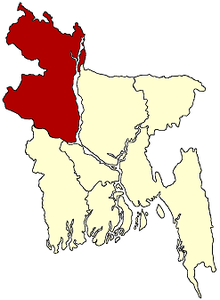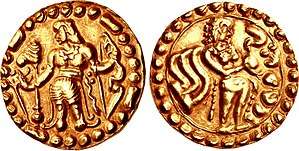Varendra
Varendra (or Barind) was a region of North Bengal, now in Bangladesh.[1] It included the Pundravardhana or Pundra Kingdom region currently part of Rangpur and Rajshahi Division of Bangladesh.


According to Cunningham the boundary of Varendra was the Ganges and the Mahananda on the west, the Karatoya on the east, the Padma on the south and the land between Koochbihar and the Terai on the north.[2]
History
Historical evidence attests significant presence of Brahmins in Bengal during the Maurya period. The Jain Acharya Bhadrabahu, regarded to be the preceptor of Chandragupta Maurya, is said to have been born in Brahmin family of Pundravardhana (or Puṇḍra, the region north of the Ganges and west of Brahmaputra in Bengal, later known as Vārendra). Such evidences suggest Puṇḍra or Vārendra and regions west of Bhagirathi (called Radha in ancient age) to be seats of Brahmins from ancient times; Rādhi and Varendra are still chief branches of Bengali Brahmins settled in these regions. Medium to large scale migrations of Brahmins from parts of India like Kanyakubja region, Kolancha, southern India and Pushkar in Rajasthan, among other places, occurred from time to time, especially during Pala and Sena periods.
According to HC Raychoudhuri the Gupta dyansty originated from the Varendri region. According to the Khalimpur copper plate inscription, the first Pala Emperor Gopala was the son of a warrior named Vapyata. The Ramacharitam attests that Varendra (North Bengal) was the fatherland (Janakabhu) of the Palas.
Traditionally, Bengali Brahmins are divided into the following categories:
- Rādhi, from the Rarh region southwest of the Ganges
- Barendra, from the Varendra or Puṇḍra region. Vārendra originally meant rain-maker magicians.
Modern usage
- Varendra Research Society
- Varendra Research Museum
- Varendra rebellion
- Varendra University
- Varendra tract
See also
References
- History of Ancient Bengal, Ramesh Chandra Majumdar, 1971
- Varendra in Banglapedia